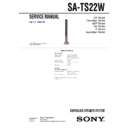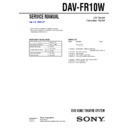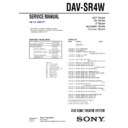Read Sony SA-TS22W Service Manual online
SERVICE MANUAL
Sony Corporation
Audio Group
Published by Sony Engineering Corporation
Published by Sony Engineering Corporation
US Model
Canadian Model
AEP Model
UK Model
E Model
Australian Model
SURROUND SPEAKER SYSTEM
9-879-098-02
2004H16-1
© 2004.08
© 2004.08
Ver 1.1 2004.08
SPECIFICATIONS
SA-TS22W
Surround (L)
Speaker system
Two-way Bass reflex
Speaker unit
70 mm dia. cone type,
25 mm dia. balance-dome-
type tweeter
25 mm dia. balance-dome-
type tweeter
Rated impedance
4 ohms
Dimensions (approx.)
255
× 1112 × 255 mm
(w/h/d)
Mass (approx.)
5.0 kg
General
Surround speaker (L)
Surround speaker (L)
Power requirements
220-240 V AC, 50/60 Hz
P
120 V AC, 60 Hz
ower consumption
36 W (220-240 V AC)
Design and specifications are subject to change
without notice.
without notice.
• SA-TS22W is speaker system in
DAV-FR10W/SR4W.
DAV-FR10W/SR4W.
2
SA-TS22W
TABLE OF CONTENTS
1.
GENERAL
...................................................................
3
2.
DIAGRAMS
2-1.
Printed Wiring Board – DIAT AMP Board (Side A) – ...
5
2-2.
Printed Wiring Board – DIAT AMP Board (Side B) – ...
6
2-3.
Schematic Diagram – DIAT AMP Board (1/3) – ...........
7
2-4.
Schematic Diagram – DIAT AMP Board (2/3) – ...........
8
2-5.
Schematic Diagram – DIAT AMP Board (3/3) – ...........
9
2-6.
Printed Wiring Board – DIAT POWER Board – ............ 10
2-7.
Schematic Diagram – DIAT POWER Board – ............... 11
2-8.
Printed Wiring Board – DIAT BUILT PD Section – ...... 12
2-9.
Schematic Diagram – DIAT BUILT PD Section – ......... 13
3.
EXPLODED VIEWS
3-1.
Base Cover Section .......................................................... 18
3-2.
Cabinet, Front Panel Section ........................................... 19
4.
ELECTRICAL PARTS LIST
.................................. 20
SAFETY CHECK-OUT
After correcting the original service problem, perform the following
safety check before releasing the set to the customer:
Check the antenna terminals, metal trim, “metallized” knobs, screws,
and all other exposed metal parts for AC leakage.
Check leakage as described below.
safety check before releasing the set to the customer:
Check the antenna terminals, metal trim, “metallized” knobs, screws,
and all other exposed metal parts for AC leakage.
Check leakage as described below.
LEAKAGE TEST
The AC leakage from any exposed metal part to earth ground and
from all exposed metal parts to any exposed metal part having a
return to chassis, must not exceed 0.5 mA (500 microamperes.).
Leakage current can be measured by any one of three methods.
from all exposed metal parts to any exposed metal part having a
return to chassis, must not exceed 0.5 mA (500 microamperes.).
Leakage current can be measured by any one of three methods.
1. A commercial leakage tester, such as the Simpson 229 or RCA
WT-540A. Follow the manufacturers’ instructions to use these
instruments.
instruments.
2. A battery-operated AC milliammeter. The Data Precision 245
digital multimeter is suitable for this job.
3. Measuring the voltage drop across a resistor by means of a
VOM or battery-operated AC voltmeter. The “limit” indication
is 0.75 V, so analog meters must have an accurate low-voltage
scale. The Simpson 250 and Sanwa SH-63Trd are examples
of a passive VOM that is suitable. Nearly all battery operated
digital multimeters that have a 2 V AC range are suitable. (See
Fig. A)
is 0.75 V, so analog meters must have an accurate low-voltage
scale. The Simpson 250 and Sanwa SH-63Trd are examples
of a passive VOM that is suitable. Nearly all battery operated
digital multimeters that have a 2 V AC range are suitable. (See
Fig. A)
Notes on chip component replacement
•
Never reuse a disconnected chip component.
•
Notice that the minus side of a tantalum capacitor may be
damaged by heat.
damaged by heat.
Flexible Circuit Board Repairing
•
Keep the temperature of the soldering iron around 270
°
C
during repairing.
•
Do not touch the soldering iron on the same conductor of the
circuit board (within 3 times).
circuit board (within 3 times).
•
Be careful not to apply force on the conductor when soldering
or unsoldering.
or unsoldering.
UNLEADED SOLDER
Boards requiring use of unleaded solder are printed with the lead-
free mark (LF) indicating the solder contains no lead.
(Caution: Some printed circuit boards may not come printed with
free mark (LF) indicating the solder contains no lead.
(Caution: Some printed circuit boards may not come printed with
the lead free mark due to their particular size)
: LEAD FREE MARK
Unleaded solder has the following characteristics.
•
Unleaded solder melts at a temperature about 40
°
C higher
than ordinary solder.
Ordinary soldering irons can be used but the iron tip has to be
applied to the solder joint for a slightly longer time.
Soldering irons using a temperature regulator should be set to
about 350
Ordinary soldering irons can be used but the iron tip has to be
applied to the solder joint for a slightly longer time.
Soldering irons using a temperature regulator should be set to
about 350
°
C.
Caution: The printed pattern (copper foil) may peel away if
the heated tip is applied for too long, so be careful!
•
Strong viscosity
Unleaded solder is more viscou-s (sticky, less prone to flow)
than ordinary solder so use caution not to let solder bridges
occur such as on IC pins, etc.
Unleaded solder is more viscou-s (sticky, less prone to flow)
than ordinary solder so use caution not to let solder bridges
occur such as on IC pins, etc.
•
Usable with ordinary solder
It is best to use only unleaded solder but unleaded solder may
also be added to ordinary solder.
It is best to use only unleaded solder but unleaded solder may
also be added to ordinary solder.
SAFETY-RELATED COMPONENT WARNING!!
COMPONENTS IDENTIFIED BY MARK
0
OR DOTTED LINE
WITH MARK
0
ON THE SCHEMATIC DIAGRAMS AND IN
THE PARTS LIST ARE CRITICAL TO SAFE OPERATION.
REPLACE THESE COMPONENTS WITH SONY PARTS WHOSE
PART NUMBERS APPEAR AS SHOWN IN THIS MANUAL OR
IN SUPPLEMENTS PUBLISHED BY SONY.
REPLACE THESE COMPONENTS WITH SONY PARTS WHOSE
PART NUMBERS APPEAR AS SHOWN IN THIS MANUAL OR
IN SUPPLEMENTS PUBLISHED BY SONY.
ATTENTION AU COMPOSANT AYANT RAPPORT
À LA SÉCURITÉ!
LES COMPOSANTS IDENTIFIÉS PAR UNE MARQUE
0
SUR
LES DIAGRAMMES SCHÉMATIQUES ET LA LISTE DES
PIÈCES SONT CRITIQUES POUR LA SÉCURITÉ DE
FONCTIONNEMENT. NE REMPLACER CES COM- POSANTS
QUE PAR DES PIÈCES SONY DONT LES NUMÉROS SONT
DONNÉS DANS CE MANUEL OU DANS LES SUPPLÉMENTS
PUBLIÉS PAR SONY.
PIÈCES SONT CRITIQUES POUR LA SÉCURITÉ DE
FONCTIONNEMENT. NE REMPLACER CES COM- POSANTS
QUE PAR DES PIÈCES SONY DONT LES NUMÉROS SONT
DONNÉS DANS CE MANUEL OU DANS LES SUPPLÉMENTS
PUBLIÉS PAR SONY.
1.5 k
Ω
0.15
µ
F
AC
voltmeter
(0.75 V)
voltmeter
(0.75 V)
To Exposed Metal
Parts on Set
Parts on Set
Earth Ground
Fig. A.
Using an AC voltmeter to check AC leakage.
3
SA-TS22W
SECTION 1
GENERAL
Surround speaker (L)
The surround speaker (L) incorporates the IR receiver. It receives the sound from the IR transmitter and
sends it to the surround speaker (R).
Connect the surround speaker (R).
sends it to the surround speaker (R).
Connect the surround speaker (R).
ON
OFF
ONLY FOR
POWER
DIR-R2
Rear side of the surround speaker (L)
IR receiver
This section is extracted
from instruction manual.
from instruction manual.
SERVICING NOTE
4-246-444-01
After service, as shown in a figure,
a power cord is fixed.
a power cord is fixed.
power cord
Label
Ver 1.1
4
SA-TS22W
SECTION 2
DIAGRAMS
• Waveforms
– DIAT AMP Board –
– DIAT AMP Board –
4
IC114
4
2
IC102
tf
(BCK)
1
IC102
rd
(OSCO)
3
IC107
wd
(X1)
20.3 ns
4.5 Vp-p
125 ns
3.5 Vp-p
325 ns
2.5 Vp-p
81.3 ns
1 V/DIV, 50 ns/DIV
1 V/DIV, 50 ns/DIV
2 V/DIV, 10 ns/DIV
1 V/DIV, 100 ns/DIV
2.5 Vp-p
Note on Schematic Diagrams:
• All capacitors are in
• All capacitors are in
µ
F unless otherwise noted. (p: pF)
50 WV or less are not indicated except for electrolytics and
tantalums.
tantalums.
• All resistors are in
Ω
and
1
/
4
W or less unless otherwise
specified.
•
C
: panel designation.
•
A
: B+ Line.
• Voltages and waveforms are dc with respect to ground
under no-signal (detuned) conditions.
∗
: Impossible to measure
• Voltages are taken with a VOM (Input impedance 10 M
Ω
).
Voltage variations may be noted due to normal production
tolerances.
tolerances.
• Waveforms are taken with a oscilloscope.
Voltage variations may be noted due to normal production
tolerances.
tolerances.
• Circled numbers refer to waveforms.
• Signal path.
F
: AUDIO
• Abbreviation
CND
: Canadian model
MX
: Mexican model
TW
: Taiwan model
Note on Printed Wiring Boards:
•
•
X
: parts extracted from the component side.
•
Y
: parts extracted from the conductor side.
•
: Pattern from the side which enables seeing.
(The other layers' patterns are not indicated.)
• DIAT AMP board is multi-layer printed board.
However, the patterns of intermediate layers have not been
included in diagrams.
included in diagrams.
• Indication of transistor.
• Note for Printed Wiring Boards and Schematic Diagrams
C
B
These are omitted.
E
Q
Caution:
Pattern face side:
Pattern face side:
Parts on the pattern face side seen from
(Conductor Side)
the pattern face are indicated.
Parts face side:
Parts on the parts face side seen from
(Component Side) the parts face are indicated.
B
These are omitted.
C
E
Q
Note:
The components identi-
fied by mark
fied by mark
0
or dot-
ted line with mark
0
are
critical for safety.
Replace only with part
number specified.
Replace only with part
number specified.
Note:
Les composants identifiés
par une marque
par une marque
0
sont cri-
tiques pour la sécurité.
Ne les remplacer que par une
piéce por tant le numéro
spécifié.
Ne les remplacer que par une
piéce por tant le numéro
spécifié.



